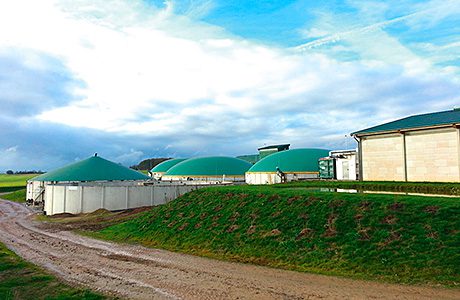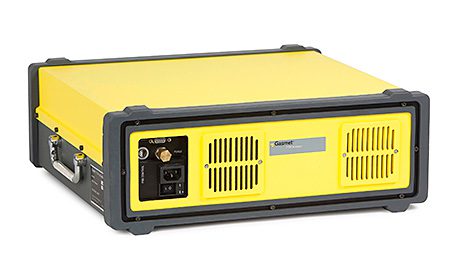
POWER generation from Germany’s enormous biogas industry produces emissions to air that are regulated by the Technical Instructions on Air Quality Control (TA Luft).
As part of the approval process, the emissions from each plant have to be tested every three years. Formaldehyde is one of the pollutants of greatest concern because of its carcinogenicity and the TA Luft emission limit is 60 mg/m³. However, the German Government has also created a financial incentive scheme to encourage process managers to lower their formaldehyde emissions to below 40 mg/m³. To be eligible for the EEG (Erneuerbare Energien Gesetz) scheme, plants must be tested every year.
Formaldehyde (HCHO) can be difficult to measure in hot, wet emissions, not least because it would dissolve in condensate if the sample gas is allowed to cool. Test engineers in Germany have therefore deployed portable (Gasmet DX4000 and CX4000) FTIR analysers to measure formaldehyde, and a number of systems are currently in use across Germany.

Biogas in Germany
The biogas industry in Germany has grown enormously in recent years; in 1992 there were 139 biogas plants in the country, but by the end of 2013 there were almost 8,000 with an electrical capacity of about 3,400 MW – sufficient for the energy needs of around 6.5 million households. Initially, biogas plants were built to handle the by-products of human and animal food production as well as agricultural waste, but with government incentives to generate renewable energy, farmers are now growing crops such as maize specifically for energy production.
Biogas is produced by anaerobic digestion with anaerobic bacteria or fermentation of biodegradable materials. The main constituent gases are methane and carbon dioxide, with small amounts of hydrogen sulphide and water. The products of biogas combustion are mostly carbon dioxide and water, but the combustion of biogas also produces formaldehyde.
Biogas-fuelled combined heat and power (CHP) plants are becoming a very popular source of renewable energy in many countries because they provide a reliable, consistent source of energy in comparison with wind and solar power. In addition to the renewable energy that these plants produce, the fermentation residue is a valuable product that can be used as a fertiliser and soil conditioner for agricultural, horticultural and landscaping purposes.
Exhaust gas tests
The exhaust emissions of each biogas plant are tested every three years for substances hazardous to air quality, such as particulates, carbon monoxide, nitrogen oxides, sulphur dioxide and formaldehyde. Most of these parameters can be measured on-site with portable equipment. However, in the early years and still to this day, the complexity of formaldehyde analysis has necessitated sampling and laboratory analysis – a time-consuming and costly activity.
In 2007 Wolfgang Schreier from the environmental analysis company RUK GmbH (now part of the SGS Group) started working on the use of portable FTIR gas analysers for formaldehyde analysis. The FTIR analysers are manufactured by Gasmet (Finland) and supplied in Germany by Ansyco GmbH, a Gasmet group company.
FTIR analysers are able to qualitatively and quantitatively analyse an almost endless number of gas species. However, Wolfgang Schreier says: “The Gasmet units are primarily employed for the measurement of formaldehyde, and whilst they are able to measure other parameters of interest such as CO, NOx and Methane, they are not yet certified for doing so in the emissions of biogas plants, unless an internal validation has been undertaken.
“The DX4000 proved to be the ideal instrument for this application because it samples at high temperatures (above 180ºC) so formaldehyde cannot dissolve in condensate, and the instrument provides sensitive, accurate, reliable real-time formaldehyde measurements – no other portable analyser is able to achieve this.
“Importantly, the DX4000 is also robust and, weighing just 14kg, it is easy to transport from site to site. In addition to a heated sample line, the only other accessory is a laptop running Gasmet’s Calcmet™ software.”
In contrast with the portable FTIR, it is typical for the results of laboratory gas analysis to become available around 2 weeks after sampling. This highlights a further benefit of the direct-reading instrument; real-time results enable plant managers to adjust their process in order to improve efficiency and minimise the emissions of formaldehyde and other gases.
Ansyco’s Gerhard Zwick says: “We hope that the other measurements that are possible with the Gasmet FTIR will also soon be accepted. A new VDI method (VDI 3862-8) for the measurement of formaldehyde by FTIR is being established and this is likely to be published at the beginning of 2014.
“The preparation of this standard involved rigorous field tests with five Gasmet FTIR analysers at a live biogas plant. During testing, samples were taken for analysis according to the existing standard laboratory methods and the results showed that portable FTIR produced even better results than lab analysis.”
Formaldehyde reduction incentive
The bonus is paid to the operators of biogas plants which are subject to approval by the Federal Emmission Control Act if certain conditions are met. Measurements to demonstrate the effectiveness of emission reduction have be taken each year by an organisation which is approved according to § 26 of the Act.
While the emission limit for formaldehyde is 60 mg/m³, according to the EEG legislative, the plant operator receives a bonus of 1 cent per kW when formaldehyde emission levels are below 40 mg/m³, with simultaneous fulfilment of the emission limits for nitrogen monoxide and nitrogen dioxide (combined), and for carbon monoxide.
With the benefit of real-time readings from the FTIR, process operators are able to employ process control measures to alter formaldehyde emissions. However, this may also affect the efficiency of the combustion process or the concentrations of other limited gases. In addition, it is now commonplace for modern plants to use a catalyst for formaldehyde emission reduction.
Summarising, Gerhard Zwick says: “The standard formaldehyde emissions monitoring package consists of a Gasmet DX4000 analyser and a heated sampling system, so no adaptations were necessary for the measurement of biogas emissions.
“We have now supplied instruments to most of the key testing organisations.”






